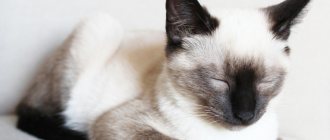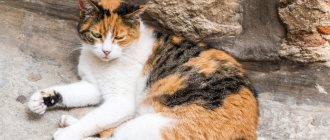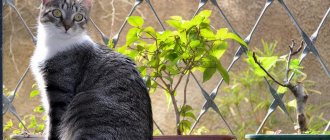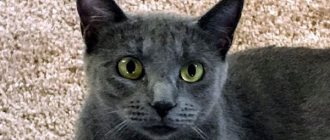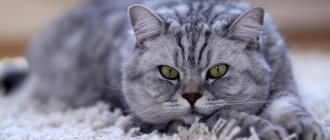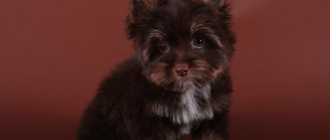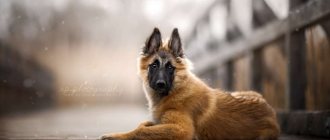The tortoiseshell color of British cats is also called tortie. This is a unique color of its kind. Tri-colored British tortoiseshells combine two groups of colors at once: black (and lightened blue, lilac, chocolate, cinnamon and fawn) and red (and lightened cream).
That is, in simple words, when dark colors meet red or cream, they get turtles.
Care and maintenance
Before you get a Briton, it is important to purchase all the accessories necessary for him:
- Sleeping area. Representatives of this breed love to be alone, so it is recommended to buy them a bed or a house, which should be placed in a secluded and quiet place.
- A bowl. Metal utensils with high sides are suitable for food, and ceramic ones for water.
- Tray. Breeders advise using a plastic high box. It is recommended to choose the filler from wood material.
- Comb. It is better to comb a soft, plush fur coat with a massage brush.
- Cloth. The British have a hard time withstanding frost, so it is worth purchasing a warm wardrobe for winter walks.
- Scratching post. It will help wean furry ones from the habit of sharpening their claws on furniture.
If the animal gets used to being in human hands, it will be easier for the owner to care for it.
When you get a British tortoiseshell cat, first of all you should establish a chain of command between the owner and the pet. If the rules of behavior are followed well, it is recommended to reward your pet by treating him with a treat. If the cat misbehaves, you should immediately scold him without using force. Despite the fact that this breed is distinguished by its cleanliness, the kitten needs to be taught to handle hands in order to calmly care for its eyes, ears, and claws, where the tortoiseshell fold cat cannot reach on its own.
Caring for British cats is not difficult, but it is worth remembering and observing some nuances. The main advantage of the breed is its coat. The animal should be combed 1-2 times every 7 days. With a special brush you can remove any loose hair and massage your furry friend. In addition, it is necessary to trim the nails twice a month, even if there is a scratching post.
You should clean your eyes with a damp cotton swab every day to avoid accumulation of discharge.
The ears also need to be paid attention. Use a cotton swab dipped in boiled water to treat the ears.
You will need to examine your mouth every day. If tartar deposits are noticed, dry food should be introduced into the diet, which successfully copes with this problem.
An important aspect of caring for cats is nutrition. Many owners prefer to feed their pets industrial complementary foods. Such food contains all the necessary vitamins and microelements. The main thing is that the tortoiseshell cat, in addition to this food, receives a sufficient amount of liquid. If your pet eats only natural products, then the diet should include raw lean meat, boiled fish and chicken, cereals and vegetables. You should feed your pet 2-3 times a day.
British cat - description of the breed
Cats have a wide chest, a rounded body and a roundish head with pronounced cheeks. Medium-sized ears set wide apart. At the same time, the Briton does not pretend to be a long animal: the length of its legs is short or medium. But the paws are really powerful.
A description of the British cat breed cannot be complete without an emphasis on the eyes, which are characterized by a bright color. This case when the eyes are like 2 saucers.
Due to the fact that this is a natural breed, cats rarely have health problems. They are very loyal, which is why they are often compared to dogs. This is the case when a pet becomes attached not to one person, but equally respects and loves all family members.
However, the British are self-sufficient, so they do not necessarily need to interact with people on a regular basis. Tails are often chosen by busy people, because the cat will not feel discomfort being alone all day.
The animal is undemanding and very smart. They are curious, so they easily join in the game or touch with funny actions. Although cats cannot be called hyperactive. Basically, they are dominated by a calm mood.
Existing types of “turtles”
The term tortoiseshell cat implies a type of coat color, but not a breed. Tortoiseshell is the result of mixing three colors in unpredictable combinations. The main components are black and red or tan. As well as light colors derived from them - cream and silver, sand and ash or white.
Types of tortoiseshell color:
- Scaly or Torti, in which black and red colors overlap one another without forming a clear outline, and the pattern resembles scales on a fish. One of the colors remains dominant, and a 50/50 ratio is rare. This type of cat color is more typical of Persian, Siberian and yard breeds.
- Patchwork or Calico, when the combination of black and red looks like a patchwork quilt. The spots are located chaotically and are clearly expressed. This color can be seen in Scots, Devon Rex and British.
- There are colors with distinct white spots mixed with the main black and red color. They can be located in the lower part of the body, while the classic tortoiseshell color predominates in the upper part.
Tortoiseshell colors are found in solid and patterned patterns. In the patterned version, in the middle of the spots there is an additional ornament, which is not present in the plain tortoiseshell color.
Tortoiseshell color is found in short-haired and long-haired cats of these breeds.
Longhair:
- Persian
- Norwegian
- American Coon or Maine
- Angora
- Kimryskie
Shorthairs are:
- British
- Cornish Rex
- Sphinxes
- Scottish Fold
- Japanese Shorttails
- Eastern
Types of colors
Selection work on representatives of the British breed, involving various bloods, has led to a variety of both colors and breed types. If initially the British had short hair with a thick undercoat, then crossing with the Persian cat made it possible to obtain semi-long-haired animals. The colors of British longhair cats correspond to the colors of shorthair cats.
Many people only think of Britons as smoky, blue or tabby cats and don't even realize how many colors the breed has. Even a pair of quite ordinary parents can produce a kitten of a rare color.
To organize the variety of colors of British cats, they are divided into types and groups according to color, pattern and method of pigmentation.
Types of colors of British cats:
- solid (or plain);
- typed: smoky, veiled, shaded;
- gold;
- silver;
- tortoiseshells;
- color point;
- particolors: harlequin, bicolor, van, mitted;
- tabbies: spotted, striped, marbled, ticked.
A table of the colors of British cats will help you imagine all the diversity.
A little mysticism
Most peoples around the world endow the tortoiseshell cat with magical properties. It is believed that “turtles” attract good luck and protect the home from misfortunes. With a pet “turtle,” the house becomes cozy and calm. And if such a cat gets in by accident, then it is prohibited to kick it out. And what sane person would refuse happiness and good luck.
In Japan, such cats are iconic, they are worshiped and legends are made about them. Almost every Japanese home has a maneki-neko figurine. This is what the locals called the tortoiseshell-colored cat. They believe that such an animal is sent on a special mission and the presence of a “turtle” in the house, even in the form of a figurine, will allow them to receive the protection of higher powers. Japanese sailors are trying at any cost to get a turtle pet that will help them avoid a dangerous storm along the way.
In popular beliefs, the tortoiseshell cat is considered a symbol of grace and luck, a protector from troubles, fires and floods. “For luck” they try to take the “turtle” cat.
A colored miracle in the house will definitely become a devoted friend and bring prosperity.
Care
Blue Britons require care in several ways.
- It happens that discharge occurs around the eyes, and this occurs in both kittens and adults. For cleaning, use a cotton swab previously soaked in an eye wash solution. If the discharge is purulent in nature, then your pet should definitely be shown to a veterinarian.
- Ears also require care. In normal condition, they should be clean, odorless and uniform in color. To clean your ears, you need to take a cotton swab dipped in a special solution.
- To comb the fur, special brushes are used, which are equipped with either rubber or metal bristles, which should not injure the pet’s skin. Brushing should be taught from a young age so that kittens already understand what is being done to them. The pet must be patient with this care. It is necessary to be especially careful when brushing during the molting period. This procedure will help prevent hair from appearing on furniture, carpets and other places. To collect the hair after the procedure, you can use a special rubber glove or a damp hand. Bathing is not included in the set of mandatory actions.
Blue British cats have excellent immunity. If you care for them properly, they are practically not prone to diseases. If there is the slightest change in your pet’s behavior, you should contact a veterinarian for help, then you can help the animal and avoid serious complications.
To learn about the intricacies of keeping blue British cats, see the following video.
Rare colors of British cats
Today, relatively new and rare uniform colors stand out - cinnamon and fawn. Dark colors of British cats are dominant, so light-colored kittens are rarely born.
Cinnamon is a very rare and desirable color, its name comes from the English cinnamon, which translates as cinnamon. The color is similar to lightened chocolate. The gene for this color, discovered 50 years ago, is recessive, so cinnamon kittens are born quite rarely.
Fawn is an even rarer color, which is a bleached cinnamon. It was recognized quite recently, in 2006, and is of particular interest to breeders, as it makes it possible to develop new lightened colors.
Fawn-like kittens, i.e., fauns, and cinnamon cinnamon kittens are classified as cream and blue at birth. To identify a rare color, a DNA examination is carried out, which confirms that the animal belongs to a rare color.
Interesting facts about tortoiseshell cats
Like jet-black cats, tortoiseshell pets have always been shrouded in various beliefs and signs. In different countries of the world, tortoiseshell cats are treated differently, but the general opinion about these animals is positive.
Thus, in ancient Rus', tortoiseshell cats were treated extremely kindly. It was believed that a three-colored cat protected the house and household from fires, and if a motley animal wandered into the house of a poor person, then very soon a substantial increase in money awaited him. In Rus', tortoiseshell cats were called “rich,” meaning both the financial aspect and God’s gift. Accordingly, by having a tortoiseshell kitten, a person could count on divine gifts: health, money, a good job or good luck, in general, what is most needed.
Residents of Russian villages readily adopted turtle cats.
In America, tortoiseshell cats are also considered “money cats,” and the appearance of a tricolor kitten in the house is regarded as a symbol of good luck, unexpected good news, and enrichment. They especially love “turtles” in Japan, and every fifth domestic cat has exactly this color. It is worth looking at the traditional Japanese porcelain figurines depicting tricolor cats.
Maneki-neko
What kind of happiness will befall the person who bought the figurine depends on the position of its head, facial expressions, size and number of spots. Japanese sellers of these souvenirs will tell you in detail which figurine to choose so that it will surely fulfill your wish. But the Japanese prefer to have living talismans of happiness, and purchase figurines only if it is not possible to have a real pet.
Residents of Britain believe that tortoiseshell cats protect the home from evil spirits and otherworldly phenomena, and also ensure peace and tranquility in the family, love between household members. The British believe that calico cats are excellent mousecatchers, and in this art they have no equal among whiskered cats of other colors.
Tricolor cats are especially revered by sailors
For this reason, motley cats have always been companions of sailors. Animals not only protected the ship, supplies and cargo from rodents - according to ancient belief, tortoiseshell cats helped the ship avoid the storm. Sailors also believe that they dream of a calico cat for a reason - if in the morning, after waking up, the sun shines, then the whole journey will be calm. If it rains, then after the cat comes to sleep, the weather will improve.
Features of tortoiseshell colors: shades and main characteristics
The spotted coat color with the interweaving of 3 basic colors and the formation of an unusual pattern by them has its own subtypes depending on which shade is predominant:
- Black Tortoiseshell: The main colors are black and red. In places where areas of red pigment are present on the fur, lightened stripes appear. Eye color – copper with a dark tint or dark yellow.
- Chocolate: the main colors are red and chocolate. Pigments have uniform saturation. Eyes - copper or yellow with an orange tint.
- Cinnamon: The base is red and a hint of cinnamon. The specificity of this type of tortoiseshell color is that world standards do not recognize it. The eyes are yellow with varying degrees of shade saturation.
Types according to the drawing. Depending on what pattern is formed on the wool, there are:
- “Torti” – this type of color is also called “scaly tortoise”. The color of the wool resembles the scales of fish. The basic colors are black and red, represented by small spots located in relation to each other in a checkerboard pattern. It is extremely difficult to find such precise geometry. In most cases, multi-colored spots have a chaotic arrangement. However, the “tortie” color has another distinctive feature - the ratio between red and black is the same. The pattern is motley, the fur is speckled with hairs of different colors.
- "Calico". This type of color has other names - “patchwork” or “calico”. There are no individually dyed hairs, and entire areas of the fur are painted in different colors, usually red or black. The spots can be located separately, overlap each other, merging, or form groups. The most striking representatives with the Calico color are the British, Sphynx and Cornish Rex.
- Turtle on white. The peculiarity of the color is that the fur on the tummy and head in the chin area is white. The entire upper part of the fur has a tortoiseshell pattern, resulting in the impression that a tortoise shell was put on top of the white cat.
In a specific color, the base shades may be spotted or striped. It is extremely rare, but not excluded, that a combination of stripes and spots occurs.
Location of the drawing. Tortoiseshell color is divided into subspecies and depending on the location of the pattern:
- There is a solid turtle - spots of different colors are evenly spaced, as such there is no pattern or pattern.
- Patterned turtle - multi-colored spots form a pattern. These can be various spirals, circles and stripes. The longer a cat's fur, the worse the pattern can be seen.
Cat breeds with tortoiseshell color
Of course, tricolor kittens are also born to outbred cats, but if a person is seriously interested in purchasing a tortoiseshell-colored pet, it would be useful to know in which breeds this color is standard. We suggest getting acquainted with the most common and popular breeds, within which “turtles” appear most often.
Tortoiseshell color is found in outbred cats
British cat
These aristocratic representatives of the cat world look great in tortoiseshell color. There are many variations of the tri-colored British, they are found in the “tortie” type, and in the “calico” and “turtle on white” variations. Breeders distinguish more than eighty types of colors included in the tortoiseshell group: black-red, beige-blue, cinnamon red, chocolate peach and the like.
British tortoiseshell cat
Oriental cat
The Oriental breed is represented by the largest number of colors in the entire cat world. These sociable, intelligent cats are carriers of one of the most beautiful tortoiseshell colors. Like the British, Orientals have more than fifty varieties of tortoiseshell tricolor: a kitten can wear a warm or cool coat, a patterned or checkerboard coat.
Oriental cake-colored kitten
Maine Coon
The handsome Maine Coons also come in a variety of colors, including tortoiseshell. In the breed you can find dozens of bizarre variations in how shades of black and red are located on the cat’s fluffy fur coat. There are also almost black individuals with barely visible white and peach hairs. It is not uncommon for Maine Coon kittens to have a “turtle on white” appearance.
Small Maine Coon, tortoiseshell color
Canadian Sphynx
Canadian Sphynxes, whether hairless, velor or brushed, can be carriers of the “tortoiseshell” color. In hairless cats, this coloring is even more interesting, since not only the millimeter-long, down-like colored fur is visible, but also the multi-colored skin of the animal. Sometimes the tortoiseshell color does not extend to the entire body of the animal, but only to the face - then the bald cat looks as if she is wearing a mask made of colorful material.
Tortoiseshell velor sphinx
Cornish Rex
Curly-haired Cornish, which have the most delicate fur covered with curls, also represent a breed group, which according to the standard includes tortoiseshell color. Especially among Cornish Rexes, variations in coloration “turtle on white” are valued, when the lower part of the animal’s body is covered with snow-white fur, and on top there are red and black spots.
Tricolor Cornish Rex kitten
Persian cat
Long-haired tortoiseshell cats look very interesting, because in this case not only the pattern, but also the texture of the hairs is taken into account. In Persian cats, the tricolor sections of the coat are intricately mixed, and the hairs can have different shades along the entire length. Turtle Persians typically have beautiful dark orange eyes that look like jewels against their colorful fur.
Longhaired Persian cat "tortie"
Norwegian cat
Norwegian forest cats, according to many, are the most spectacular representatives of the tortoiseshell color. Animals with the “turtle on white” type are more common. Thanks to their long, very lush and rich coat, Norwegian Forest cats boast unusual color transitions and layers of shades.
Norwegian forest turtle
Scottish fold cat
Funny cats, seemingly devoid of ears, in tortoiseshell color are especially reminiscent of a forest owl. This breed is related to the British and therefore has similar types and shades of tricolor. The coat of a Scottish cat can have both cold charcoal and warm chocolate shades. More common are motley cats, the “torti” subspecies, with very rich, bright coat pigments.
Scots Fold, "torty" color
Turkish Angora
Despite the fact that Turkish Angoras were bred as completely snow-white cats, over time, breeders introduced various types of colors, including tortoiseshell. Among Angora cats, the “tortoise-on-white” type is especially common, with the light coat having a particularly vibrant whiteness. The colored areas of the fur coat are usually bright and saturated.
Turkish Angora Tricolor
Calico cat breeds
In the English-speaking world, the calico cat is called the Calico cat, a name associated with the colors of cotton fabric invented in Calicut.
The Japanese name for the tortoiseshell is Mike, mike-neko (三毛猫), the literal translation means “tricolored cat.” In Dutch it is lapjeskat, which means "patchwork cat".
But all these names have nothing to do with a specific breed. The combination of three different colors can be found in various breeds, such as Neva Masquerade, Siberian, Maine Coon, Turkish Van and others.
Siberian cat
This is one of the oldest natural breeds in Russia. It is believed that the animals originated from oriental cats, brought to Siberia by merchants and mutated in the harsh climate.
Long coat with a thick undercoat can be of a wide variety of colors, including tricolor. With bright emerald eyes, female Siberian tortoiseshells are one of nature's most beautiful creations.
By nature, these pets are independent and self-sufficient, but sincerely devoted to humans, excellent hunters and fishermen.
The folklore cat Bayun is precisely the Siberian.
Neva masquerade cat
This variety was bred in Russia not so long ago. It is the result of selection of Siberian and Siamese. She adopted the long coat from the first, and the point color from the second.
Its tortoiseshell variety is called tortoise point and is one of the most outstanding and sought after. Often this color is combined with tabby (torby point).
British shorthair cat
This breed has a unique tortoiseshell color - it has more than eighty shades and is divided into a separate group, which in turn is divided into subgroups:
- classic turtles;
- smoky turtles;
- torby (tortoiseshell tabby);
- tortie (tortoiseshell color point);
- calicos (patchback turtles);
- mixed (tortoiseshell tabby plus white).
The black color of a British tortoiseshell can appear in different variations: charcoal, blue, lilac, chocolate, fawn, cinnamon.
Scottish cat
The Scottish Fold is a British fold and differs from it only in the shape of its ears - their tips are curved and hang down. All color variations are the same as the straight fold.
Manx
This Irish native breed is distinguished by the absence of a tail. The short coat with a dense padded undercoat comes in a variety of colors. Tortoiseshell - very common.
Cymric
The cat with a very fluffy double coat is a relative of the Manx and differs from him only in the length of the hair. A very beautiful and devoted animal to humans, it often comes in a tricolor color.
Maine Coon
The natural hybrid breed is often called a coon cat. This is one of the largest breeds in the world. Calm and good-natured beauties with long hair come in various colors. Tricolor is quite common.
Persian cat
One of the most ancient breeds in the world. The cat with the longest hair - hair length reaches 12 centimeters.
Persian has a rather complex character, but he is sincerely attached to people and cannot live without human care.
The colors are numerous and varied. Tortoiseshell is found in various varieties.
Turkish van
Another oldest eastern breed. The color of this long-haired cat is always predominantly white, and its eyes are often different (blue and green). In the case of the tortoiseshell color - this is a clear Harlequin type - the spots of red and black are few in number and are found on the head, paws and tail.
Van's character compares favorably with Persian; he is good-natured and playful. An excellent swimmer, fisherman and hunter.
American shorthair cat
This is one of the oldest breeds of the New World. The short, dense coat comes in a variety of colors.
Tricolor is widely available in various color combinations.
Exotic cat
The short-haired version of the Persian cat compares favorably with its relative. This is one of the most sought after breeds in the world precisely because of its wonderful character.
The colors are very varied, tortoiseshell is quite common.
Japanese Bobtail
The national short-tailed cat of Japan, with which many legends are associated.
The tricolor color for this breed is one of the most common. Bright spots of black and red colors are located on a white background like a Harlequin.
Kurilian Bobtail
The indigenous breed of Kamchatka has a distinctive feature - always half-extended claws and a short tail. An excellent hunter and fisherman has an independent and freedom-loving character. But if it chooses its owner, it becomes attached to him forever.
The tricolor color of this breed is always of the Harlequin type.
Where are the tortoiseshell cats?
Surprisingly, the tortoiseshell color appears only in females, but cats are not born colored. Explanation of the phenomenon in terms of genetics.
Males and female cats have a different chromosome set. Cats carry two chromosomes of type X, and cats carry X and Y. The science of genetics claims that it is the X chromosome that is responsible for the color of the fur, red and black. The presence of two X chromosomes in cats leads to the fact that in addition to white, their color can also be black and red.
Due to genetic predisposition, only cats are born tricolored. A cat with three colors is a unique phenomenon. Special cats are still born. About one in 3,000 females has an extra X chromosome and the XXY genetic makeup. He has to pay for the mutation. A genetic failure results in infertility, Klinefelter syndrome, and abnormalities in the endocrine system. Such cats are too sickly and in rare cases live to adulthood.
Genetics
It is worth noting that targeted breeding of tortoiseshell cats is impossible. The chromosomes responsible for color are arranged chaotically and cannot be influenced or ordered in any way. The tortoiseshell color is an accident.
Why are there almost no tortoiseshell cats?
Cats, like male other mammals, have only one X and one Y chromosome (XY). This X chromosome does not undergo X-inactivation, and the color of the coat is determined by which allele is present on it.
Accordingly, the male's coat will either be completely orange or not orange. Very rarely (in approximately one case in three thousand) a male tortoiseshell or “calico” is born.
These animals are more likely to have an extra X chromosome (XXY), a condition known in humans as Klinefelter syndrome, and their cells undergo the same X inactivation process as females.
As in humans, these males are often sterile due to an imbalance in the sex chromosomes.
Some tortoiseshell cats may be genetic chimeras (having both male and female reproductive organs), which is the result of the fusion early in development of two fraternal twin embryos with different color genotypes. These Torti males can only pass on one color to their offspring, but not both, depending on which of the two original embryos their cells came from.
Other male Torties have mosaic genetics, in which the XXY condition occurs after conception and the animal has a mixture of cells with varying numbers of X chromosomes.
All but about one in three thousand rare male calico or tortie cats are sterile due to a chromosomal abnormality, and breeders reject any exceptions for breeding purposes because they are generally of poor physical quality and fertility.
In any case, since the genetic conditions for calico coloration are related to X, the coloration of a fertile male will have no bearing on the coloration of any male offspring (who will receive a Y rather than an X chromosome from their father).
What signs, beliefs and superstitions are associated with tricolor cats?
Can a calico cat in the house bring good luck to its owners? There are many signs and superstitions associated with tricolor cats, both in Russia and in Europe, America and Muslim countries. It is believed that a colorful pet has magical powers and brings wealth and success.
Almost all signs concerning “turtles” are related to money. It is believed that the house where such a cat lives will always be full, and the owners will have good luck in financial matters. For a long time, businessmen, bankers, and entrepreneurs have tried to keep such pets. They believed that an animal endowed with mystical powers could increase their wealth, protect them from scammers and thieves, and even ward off pirates!
The tricolor cat came into the house on its own - why is this? Just by appearing, a tortoiseshell cat brings good luck. If she accidentally strays towards the house, under no circumstances should she be driven away. A multi-colored cat will bring happiness, and unmarried girls should prepare to enter into a happy and profitable marriage.
Another sign is related to how exactly a cat should appear in a new home. Often, owners give newborn kittens away to their friends as gifts, just to get rid of them as quickly as possible. Legend has it that you must pay for a tricolor kitten so as not to get good luck for nothing. Money can be symbolic, even one penny is enough.
Three-haired cats are credited with not only helping with money matters. People say that they know how to relieve pain and treat their owners. The animal lies down on the sore spot and relieves the painful sensations with its quiet and monotonous rumbling. Scientists have proven that there is some truth in this sign; cats can actually lie down at the site of inflammation, because the temperature there is higher than in other parts of the body.
Of course, these are all folk signs and superstitions, and everyone decides for himself whether to believe in them or not. What can be said for sure is that a playful pet with an unusual color will definitely bring a lot of joy to its owners.
Games of genetics or how the tortoiseshell color came about
The tortoiseshell color has one amazing feature - such an unusual pattern on the coat is characteristic exclusively of females. It is almost impossible to meet a cat with a variegated, multi-colored color, although such a possibility cannot be completely ruled out. The reason for this is a genetic mutation inherited by female kittens from their mother cat. However, such a mutation causes serious difficulties in reproduction.
Features of genetics that determine color:
- The chromosomes that determine the sex of an animal are X and Y. XX is a cat, XY is a cat.
- Chromosomes that carry information about color: O - red, o - black.
- The Y chromosome does not carry information regarding the color of the coat; it does not have genes for either red or black colors. And the X chromosome contains only jet black or red shades. For this reason, cats with XY are extremely unlikely to be born with a tortoiseshell-colored coat. For every 3,000 cats with an unusual pattern, there is only 1 male.
Color options for cats with XX chromosomes:
- XO + XO = pure red color;
- Ho + Ho = absolutely black;
- XO + XO = tortoiseshell pattern.
It is not possible to obtain an unusual color with an interweaving of 3 basic colors through targeted selection. This is explained by the fact that the chromosomes have a chaotic arrangement and cannot be ordered.
It is unknown what will happen next, but at the moment, the tortoiseshell color of a cat is a matter of chance, which is not possible to predict, much less predict. Even a cat with a tortoiseshell color can give birth to kittens of a pure shade - black, white or red.
Blue solid
This is the color that comes to mind when thinking about the British, so we'll start with it. It is often called classic, or simply gray. The coat should be a single color, the undercoat may be lighter, but white hairs are not allowed. A lighter color is considered valuable. A small kitten may have stripes that disappear as they age. The beautiful rich amber eye color of blue Britons develops with age, although kittens are born with gray and blue irises.
Varieties of tricolor color
It is a mistake to think that the tortoiseshell color combines only black, red and white. The interaction of the orange gene with other genes can produce other colors.
If the animal initially has a silver, light brown or blue color, then the pheomelanin pigment will give a color different from red. The most common shades of “turtles”:
- cream and blue;
- chocolate and red;
- brownish and purple.
The table below shows the varieties of full and diluted tortoiseshell colors:
British black tortoiseshell kitten
| Color name | Colors | Characteristic | Eye color |
| Black | Black and red | The red pigment is lightened in places | Amber, copper |
| Chocolate | Red and chocolate | Uniform pigment saturation | Yellow, orange, copper |
| Cinnamon | Cinnamon and red | Considered a deviation from breed standards | Yellow |
| Cream blue | Cream and blue | Very rare and expensive color | Copper, green, orange |
| Creamy lilac | Cream and lilac | Predominant in long-haired cats | Green, copper, orange |
| Cream fawn | Fawn and Cream | Not recognized by standards | Dark yellow, green |
British cat of creamy blue tortoiseshell color
Sometimes the animal's fur is colored predominantly white (5/1), and only occasionally there are colored spots. This variation of tortoiseshell coloring is called “harlequin”. If white spots evenly alternate with colored ones or completely occupy the lower part of the body, this is a “calico”. You can see what the different color options look like in the photo.
Amazing and unpredictable colors
The tortoiseshell color of British cats can consist of the following color palettes:
- purple and blue;
- cream and red;
- black, chocolate and brown.
British tortoiseshells have short, soft, thick fur. The spots on the coat are mixed evenly and painted in different colors. Sometimes short stripes or spots on the face of red, black or cream colors are noticeable. The British may also have cream “socks” on their paws. The nose can be pink or black.
Outwardly, these cats resemble teddy bears. The breed of animals requires well-developed muscles, a chest, and short but strong limbs. The weight of males varies within 10 kilograms, and females - 7. The cats have a large head, with voluminous cheeks and round eyes of a copper or golden hue. The ears are small, giving rise to the name British Fold.
Formation of color
In a small pet, the brightness of the color is not as intense as in an adult.
The correct tricolor coloration is characteristic exclusively of females. The British cat is not tortoiseshell. This is due to the fact that cats have 2 X chromosomes in their genetic makeup, which are responsible for producing a black or red tint. When they are combined, the result is a tortoiseshell color. Males only have one X chromosome, so their coat will be black or red. The color appears gradually. British tortoiseshell kittens are born with a small number of cream spots. As the baby grows, their number and size increases. The undercoat of pets is gray or muted red.
The most common breeds that produce tortoiseshell kittens
An unusual tricolor color is found among representatives of some breeds:
- Persians;
- Siberian;
- Maine Coons;
- bobtails, regardless of subspecies;
- Turkish Angora;
- Cornish Rex;
- orientals;
- Scots;
- Norwegian forest cats;
- sphinxes;
- British.
Each of these breeds has its own characteristics of tortoiseshell color:
Scottish and British - these breeds have a tortoiseshell color that is recognized as an international standard. But this does not give them an advantage. As practice shows, in most cases experts do not particularly favor representatives of these breeds with a bizarre coat color, and the likelihood that the animal will win at the exhibition is extremely low. But with the acquisition of these cats, on the contrary, it is a completely different story. British or Scottish tortoiseshells with this coat color are bought much more willingly, because cuter creatures simply cannot be found.
Cornish Rex. Representatives of this breed are endowed by nature with such an unusual coat structure that any color on it will look truly amazing, and tortoiseshell color even more so. In combination with the unique grace and natural aristocracy that is felt in every movement of the cat, the tortoiseshell color adds even more impressiveness, classifying the animal as one of the world of “bohemia.” According to the breed standard, the color of their coat should not combine many shades, but tricolor is very welcome among experts.
Bobtails. Regardless of the subspecies of the breed, the tortoiseshell color is recognized as a standard and is very welcome in individuals. However, these animals are popular not only due to their often unusual coat color. Bobtails are distinguished by high intellectual abilities and sociability. Unlike most cats, tortoiseshell bobtails are the best and easiest to train.
Turkish Angora. It is commonly believed that these cats should be pure white as snow and have heterochromia (different colored eyes), however this is not entirely true. Among Turkish Angora cats, tortoiseshell coat colors are often found, which are of great value.
Maine Coons
These cats attract everyone's attention with their large size and powerful torso. Impressive dimensions, proud, independent look and originality of character against the background of tortoiseshell color make Maine Coons especially attractive to cat lovers and even a little mysterious.
Sphinxes
Surprisingly, but true: a breed such as the Sphynx, characterized by a complete absence of hair, can have a tortoiseshell color on its bare skin. Despite the non-standard appearance, the unusual lack of fur, “naked” individuals have recently become increasingly popular. The reason is the incredibly flexible, easy-going nature of the animals, their friendliness and affection towards the owner and all household members.
Orientals. If in other breeds experts disdain tortoiseshell colors, although this is allowed by the standard, then in Orientals this color is only welcome. The breed standard allows for mixing 4 colors. These cats are incredibly smart, wise in an oriental way and, despite their outward independence and independence, they really love communication with people and even need it.
Persians, exotics. These breeds occupy a leading position in choice as pets. Tortoiseshell color is not common among them, but it cannot be called rare either. Such an unusual combination of colors on long fur makes cats incredibly beautiful and attractive.
Norwegian. Among all the breeds, it is generally accepted that the Norwegian Forest cat in this color looks the best. Thanks to the thick and long coat, the color transitions and intricate lines formed by them look especially elegant and unique.
Outbred murki.
Tortoiseshell colors are also found among yard cats.
BRITISH TORTIE KITTENS
British tortoiseshell kittens are born from parents of different color groups, for example, mom belongs to the black group and dad to the red group (or vice versa). Such British tortoiseshell kittens are just a treasure for breeders who take them for further work in the nursery. The fact is that babies from turtles come in such a wide range of colors that you cannot get from any other cat.
The surprising thing is that British tortoiseshell cats are unique - there are no repetitions or “samenesses”, each cat is elegantly colored in its own way and no two cats are alike.
For photos of tricolor British tortoiseshell kittens, see the sections divided by color type.
In our nursery you can buy a British tortoiseshell kitten. See the section “KITTENS FOR SALE”.
| In our cattery you can “buy a real British kitten.” We have many different colors, we will help you choose and answer all your questions! |
British character
The main character traits are:
- independence;
- patience;
- touchiness;
- stubbornness.
Such pets are not very affectionate and can even scratch a person.
A British woman will not sit in the arms of a man, even if he is her owner. You can pet a cat only in that situation if she herself wants it. Since cats are willful, they do not ask their owners for food. Pets prefer to sit next to the bowl and wait until they are fed. They don’t respond to “kiss-kiss” either, only to their own name. The tri-colored Briton is independent. Even small kittens, following the example of their mother, begin to independently go to the place designated for the toilet. Cats are also known for their cleanliness, so they wash themselves often. In addition to the advantages, there are also unattractive aspects of the character. Cats love to throw objects off surfaces and bite and scratch their owners, especially kittens. They do not hesitate to climb into and explore bags, packages and boxes.
Mr. Cat recommends: the character and characteristics of tricolor cats
It is difficult to identify any distinctive character traits of tricolor cats, since they belong to different breeds.
But pets of this color have always been especially loved by people - rumor has attributed many good qualities to them. Without exception, all signs about such animals are positive; it is believed that with this pet in the house there will always be good luck, joy, prosperity, and well-being.
Maybe this is why calico cats are usually friendly, sociable and devoted to the owner and all household members. They are also friendly towards strangers, unless they express a threat to the owner - then the cat will turn into a fierce defender.
But at the same time, these animals are independent and self-sufficient; they do not like it when excessive attention and affection are imposed on them. Calicos are especially wary when visiting a veterinarian and can even show aggression.
The owner must take care of the visit to the clinic in a timely manner - give the pet a sedative, put on a special muzzle, caress and support the animal.
What is tortoiseshell color
The origin of the tortoiseshell color in cats is as unusual as the color itself. It is, of course, fixed genetically, like other phenotypic characteristics of an animal, and is inherited from parents to children. But only in the rarest, even exceptional cases, can a tortoiseshell cat give her tricolor to her sons - only to her daughters.
tortoiseshell coloring is transmitted mainly through the female line
Reasons for appearance
The reasons for such gender discrimination are based on differences in the chromosomal “complement” of males and females. The standard set of a female is XX, and in a full-fledged male it looks like XY: Y is a purely male chromosome that does not carry genes responsible, in particular, for color. But nature has outlined a clear mechanism according to which cat offspring inherit the colors of their parents.
Let's try to explain the complexities of color genetics in the simplest terms. Alleles—genes responsible for the inheritance of a particular color—can only be found on the X chromosome. Consider, for example, the black, red and white tortoiseshell pattern. Each X has one allele: B - black (b - chocolate) or O - red (o - cream). Two X+X in a cat is an opportunity to “place” both black and red colors (or their lightened versions) at the same time. But with only one X, the cat won’t be able to do this: either only black or only red.
Seals born from a tortoiseshell cat can be black or red - but not tricolor
Video: about the genetics of tortoiseshell color
Varieties
It’s simply hard to imagine a more bizarre color. Nature, like a careless artist, mixes colors on a palette, and sometimes jokes cheerfully, applying them to cats’ fur coats. Depending on the size, shape and location of the color spots, different types of tortoiseshell colors are classified.
Table: complete tortoiseshell colors
| Color name | Wool colors | Peculiarities | Eye color |
| Tortoiseshell black | Red and black | areas with red pigment are lightened in places | dark yellow or dark copper |
| Turtle chocolate | chocolate and red | pigment saturation is usually uniform | yellow, orange or copper |
| Turtle cinnamon | red and cinnamon | color is not recognized by breed standards | yellow and dark yellow |
The Torby color is rarely seen and is highly valued.
One color cannot combine full and diluted colors - black-cream, red-blue and similar mixes are signs of genetic mutations.
Table: diluted tortoiseshell colors
| Color name | Wool colors | Peculiarities | Eye color |
| Tortoiseshell blue-cream | cream and blue | rare and quite sought after color | copper, green or orange |
| Tortoiseshell lilac-cream | lilac and cream | looks especially good on long thick coats | copper, green or orange |
| Tortoiseshell cream fawn | cream and fawn | color is not recognized by breed standards | green or dark yellow |
Diluted tricolor colors look elegant
Colors with large areas of white are classified into a separate group called "calico". In such cases, up to half of the animal’s fur can be painted white: usually the lower part of the body along with the paws. The skin under the white fur is pink. The red and black spots on the calico's coat differ from the usual tortoiseshell color by having clearer contours and richer pigment.
Table: full calico colors
| Color name | Wool colors | Peculiarities | Eye color |
| Calico black | black, red and white | areas with red pigment are lightened in places | dark yellow or dark copper |
| Calico chocolate | chocolate, red and white | pigment saturation is usually uniform | copper, green or orange |
| Calico cinnamon | cinnamon, red and white | color is not recognized by breed standards | green or dark yellow |
With the Calico color, the black areas of the coat are uniformly colored, and the cream or red spots may be brighter in places and lighter in others; this gradation is much more noticeable than with a tortoiseshell color.
Calico varieties look brighter than tortoiseshell colors
Table: diluted calico colors
| Color name | Wool colors | Peculiarities | Eye color |
| Diluted Calico | white, cream and blue | rare and quite sought after color | copper, green or orange |
| Lilac-cream with white | white, lilac and cream | looks especially good on long thick coats | copper, green or orange |
| Cream fawn with white | white, cream and fawn | color is not recognized by breed standards | green or dark yellow |
How to determine the color of a British cat?
If you really need a kitten of a certain color, you should contact a cattery with a good reputation. It’s not a fact that you will immediately find what you want, especially if the color is rare. Ask for photos, videos; Perhaps they will show you the baby on Skype. Then it’s time to go and choose.
To begin with, visually, but the kitten must already be mature (3-4 months). In babies, the color may change color.
Look at the kitten's parents, talk with the owners, study the breed codes and the summary color table. The exact details of cat fathers and mothers must be indicated in their documents. Using the table, you can determine which kittens a given pair of producers may have.
Well, or you can contact a specialist, an expert felinologist. In the case of rare and complex colors, it is better not to take risks. Interestingly, all cats are initially wild-colored (tabby). That is, spotted. But due to a combination of genes, this color is hidden. Nature's jokes can be observed in small kittens, which, being born with spotted fur, change to one color within a couple of months.

